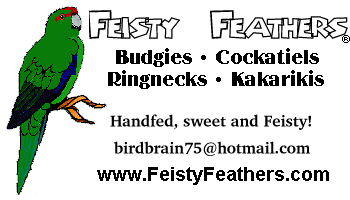

Letter
Just a few questions for you...We are living with my husband's parents. They have a cockatiel
and I don't know how old he is or how long they've had him. I am afraid of this bird because if
you come near his cage, like to feed him or get to the hamster cage, he makes a low screeching
noise and clicking sound and opens his mouth as if to bite. He's so pretty but no attention
gets paid to him or the other caged pets. I DO IT...I clean the cages (except for the bird,
my father-in-law does that) and feed and water them. But I would love to play with this pretty
bird. I sit at my computer all the time and he stares and chirps at me and sings. But, he goes
nuts when the phone rings and when you leave the room. He starts chirping in this loud,
earpiercing noise, and it hurts. I I talk to him and try to offer him a carrot now and then
and lately he just walks away. It's almost like he isn't trying to attack me much less scare
me off. Can you offer some advice so he can warm up to me? By the way, these are all my little
sister-in-law's pets. She's only 7 so she doesn't tend to them, since they were all given as
gifts. Thank you for your time.
Reply
Taming a bird isn't easy and rest assured that you will acquire several bites. How severe
depends on the bird. Many birds will only mock bite or bite lightly to show their displeasure.
The first thing you need to do is check to see if the wings are clipped. If they are not you
must get them clipped. Trying to tame a bird that can fly all over the room is virtually
impossible. The feathers will grow back with the next molt and clipping does not hurt.
The best way to start out is the bathroom method. Use an old shirt to gently get the bird out
of the cage. Roll him up in the shirt and take him into a small, confined area. You want a
room that is small and has virtually no furniture (bathrooms and closets work best). There are
several things you can do while you're in here depending on how receptive the bird is. I
usually begin with the wrapped bird on my lap (remember to make sure the little guy can breathe
whenever you wrap it). I sweet talk it and try to stroke it's head. Foot massages and head
scratches are great for teaching a bird to associate people with good. Some birds are okay with
being touched while others freak out.
There is a big difference between a scared bird and one that doesn't like people. If the bird
is terrified it's a good idea to let it out of the towel to roam or cower in a corner. Scared
birds are hard to work with and need to learn to trust you first. You can sit and read while
the bird is in the same room or you can gently talk to it. When it calms down you can inch
across the floor, trying to look non-threatening, talking sweetly and offering a treat.
Eventually you can try the lap again.
If the bird doesn't freak out when you try to touch it or just tries to bite you can keep it on
your lap. Many biters stop once they realize you're not out to hurt them, though they may mock
bite. A very important part of taming involves correctly responding to bites. DO NOT PULL
BACK. Don't scream, yell "ouch!" or flinch. These all tell the bird that biting has worked.
Instead tell the bird "no" in a firm voice. Birds respond very well to changes in your voice.
If you use a sweet voice and baby talk all during taming the bird will notice it when you say
"no" firmly. After a "no" go back to sweet talk and try petting the bird again. The back of
the head is the safest place to start a head scratch but you want to evenually go for the area
over the ears (the orange cheek patches). That's a sweet spot. Birds have sensitive feet as
well and foot massages are greatly appreciated, though many birds are nervous about you
touching their feet at first.
Eventually you can loosen the shirt bit by bit and let the bird just sit on your lap. You can
try to keep petting or you can offer a treat. Good treats to use are things you know the bird
likes. Most parrots will go for fruit (I'm taming a green cheek conure now that really loves
cherries and grapes) or peanuts. A tiel might like sunflower seed or millet spray. Sunflower
should NOT be in it's regular seed mix (it's very fatty) and makes a good treat. Treats should
be placed in the lap first. Taming birds won't usually take food from your hand right away.
These taming sessions should continue for 20-30 minutes each day until you feel the bird is
warming up to human contact. Then you can try putting it on a playstand in some other room
where you want to hang out, like near the computer, sofa or reading chair.

All articles and images contained on this site are © 1998, 1999 by Feisty Feathers unless otherwise noted and may not be reprinted or used in any way without the author's permission.